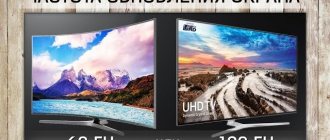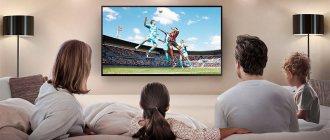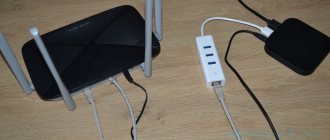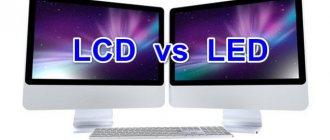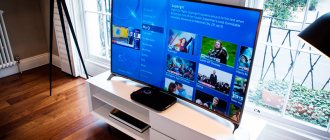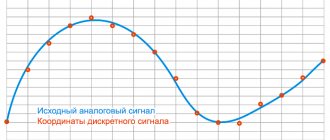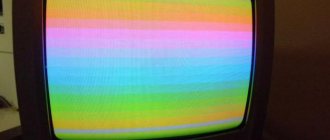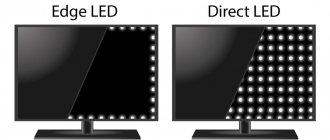The main component of modern plasma panels is rightfully considered to be the matrix. They are presented in several varieties with their own parameters and characteristics. But their main function is the same - to ensure high quality of displayed images. This factor must be taken into account when choosing a TV or display, since each matrix is designed for specific operating conditions and works best in a specific environment. Next, let's look at which TVs have the best matrix.
What is a matrix
The general design of the matrix used in televisions is a system that includes narrow, colorless electrodes. They are placed parallel to each other in the same plane vertically or horizontally. If such a matrix is depicted as a diagram on paper, it will turn out to be a grid with square slots.
The entire set of electrodes is located inside plates made of film or glass. Electrodes located vertically do not touch each other. Thus, the matrix can be schematically represented as a sheet of paper with luminous dots printed on it. Lighting up in a certain sequence, they produce the desired image.
For the manufacture of matrices, special technologies are used that affect the quality of pictures broadcast from the screen. Conventionally, they can be divided into three main types:
- LCD. This technology is used in liquid crystal displays.
- LED. LED backlighting of LCD screens.
- Plasma. A special technology is used. An electric current is passed through the gas, under the influence of which light is emitted.
Currently, liquid crystal structures are considered the cheapest and most economical. In this regard, plasma products have practically already left the electronics market. At the same time, LCD matrices are available in several versions, with different properties and different prices. Despite the apparent commonality of the technology used, the image quality of each type differs significantly.
Toshiba 40S2550EV
A 40-inch Toshiba TV model with an IPS matrix and a resolution of 1920x1080 pixels. Backlighting on LED strips provides brightness up to 250 cd/m2. The scanning frequency is not inferior to standard TVs - 60 Hz. Viewing angles - 178 degrees.
The integrated receiver supports digital and analogue broadcasting. The functions of a satellite and cable receiver are performed by a tuner. Using two HDMI connectors, you can connect a media player or computer, eliminating the need for cable TV. SCART, VGA and classic “tulip” connectors are available. The TV can be connected to a computer as a monitor, a USB port is available and support for major formats.
Acoustic system - two speakers with a total power of 16 W. The stereo system is connected via a 3.5 mm jack. The standard bracket allows you to mount the TV on the wall.
Which matrix is better to choose for a TV?
With a wide variety of matrices, you should take advice from experts on choosing the most suitable option:
- In specific and inconvenient places, the viewing angle is of great importance. In this case, IPS is suitable.
- High and high-quality color rendering is provided by VA systems.
- For infrequent viewing, you can limit yourself to a budget option with a TN matrix.
- The best images are provided by OLED and QLED technologies. It is recommended to choose the first option without an additional white LED. The picture will be more contrasty with a wide viewing angle. However, the high price of these devices should be taken into account.
Philips 40PFH4100
Sixth place in the ranking is given to the 40-inch Philips LCD with an IPS matrix, which stands out for its high image quality and original design. The backlight is LED strip, the resolution is quite standard - 1920x1080 pixels. Viewing angles are ideal for what the IPS matrix on the TV provides - 178 degrees. The frequency is only 60 Hz, but for a model not equipped with 3D, this is enough.
The dual tuner supports digital and analogue TV broadcasting. Among the declared standards are T and DVB-C, which are sufficient for cable TV, but not for terrestrial TV. Connection is made via HDMI, analog VGA and universal SCART connectors. There is a function for playing files from USB drives and recording programs on an external hard drive or flash cards.
Audio is produced by 16W speakers. External acoustics can be connected via a 3.5 mm jack or “optics”. A universal bracket is supplied with the TV.
Which matrix is better for a monitor?
Quite often, when buying a computer, the problem arises of what type of matrix to choose for the monitor. To do this, you need to compare several options and choose the most suitable one. The main parameters are:
- Viewing angle. In first place are the most expensive OLED and QLED. They are followed in descending order by IPS, VA and TN.
- Response time. OLED and TN have the best performance, despite the latter's low price. IPS and VA matrices are at an average level.
- Next, we select the color rendition. OLED and QLED are considered the most effective, followed by IPS and VA. In last place is TN.
- Contrast. For all matrices it is approximately at the same level as color rendition. The same applies to the cost of products.
The final choice is made individually, taking into account future operating conditions.
Modern OLED or QLED technologies
Organic light-emitting diode (OLED) - organic light-emitting diodes. It was they who replaced the filters with gratings.
The technology involves placing three or four OLEDs in each individual pixel (image point).
Diodes emit light in the blue, red, white and green spectrum. Combinations of these colors can synthesize countless shades of all kinds of colors. Organic diodes are good because they can be turned off or dimmed - the characteristics of each light unit can be locally adjusted. The control is performed by a powerful graphics processor. Therefore, on OLED screens, the eye distinguishes thousands of shades of gray, absolute black. And this is the contrast and detail of the picture.
| OLED | QLED | ||
| pros | Minuses | pros | Minuses |
| Excellent image contrast | Price | More vivid picture | Lower contrast |
| Instant Sweep | Relatively short LED lifespan | Increased brightness | High price |
| Viewing angle almost 1800 | It’s comfortable to watch TV in a bright room | Backlight is used | |
| No image distortion | Large case sizes | ||
| Natural color reproduction without unnatural tonal saturation | |||
| Maximum realism of the reproduced picture | |||
| Does not require light filters or LCD matrix | |||
| Suitable for use in bright rooms | |||
QLED technology is considered a cross between LCD LED and OLED. It is called a marketing ploy by Samsung. They use Quantum-dot Light-Emitting Diode, or LED elements based on quantum dots. The latter are small semiconductor fragments. They are located in each pixel. "Quantum dots" generate their own light when a beam of light passes through them (classic LCD backlight). Due to the additional LED element (light source), these TV models have an increased body size.
Answering the question, which type of TV screen is better - OLED is better, since with excellent image quality its physical parameters are smaller and energy consumption is lower.
LG 32LF510U
The LG TV model with an IPS matrix is completely Korean-made. It’s not for nothing that LG is considered the best developer of IPS screens: they are not inferior in quality to Sharp. TV diagonal - 32 inches, resolution - 1366x768 pixels. The model cannot be used as a monitor, but it is ideal as a TV. Viewing angles are standard - 178 degrees, scanning frequency - 300 Hz.
The tuner supports analogue and digital broadcasting and receives signals from satellite, terrestrial and cable television. Interface ports include USB with storage support, HDMI, antenna inputs, audio jacks and SCART. Sound output to the home theater is carried out via an optical output or a standard 3.5 mm jack.
The acoustic system - 2 speakers of 6 W - are responsible for sound reproduction. There is a function that supports Virtual Surround sound. Almost all available audio and video formats can be played from flash media. Wall mounting is standard - VESA 20x20 centimeters.
TN
Literally, the abbreviation TN stands for “Twisted Nematic Crystal”. Here, all the elements in the cells are arranged in a spiral. The technology is distinguished by its comparative cheapness, so the price of replacing the matrix on a TV, as well as its cost, does not hit the pocket so hard.
Advantages of TN matrices:
- minimal screen response compared to other technologies;
- more than affordable price tag for TVs with a TN system;
- energy saving.
Flaws:
- small viewing angles in all planes;
- relatively weak color saturation;
- the obvious black color is often replaced by hints of grey.
V.A.
Literally translated – “vertical alignment”. This technology was developed by Fujitsu brand engineers, and after a couple of months of exclusive use, it appeared in other manufacturers. Unlike the first two types of matrices, there are no spirally twisted elements here, and the light does not go beyond the boundaries of the liquid crystal layer.
Advantages of VA technology:
- the highest contrast compared to other types of matrices;
- rich and deep black color without a hint of gray;
- excellent color rendition and natural gamma.
Flaws:
- colors begin to “dance” even with a slight change in viewing angle.
A couple of years ago, VA technology had a receiver - MVA. It has absorbed the positive features of the base matrix, and the viewing angles have increased noticeably.
LG 32LF580V
LG, a recognized manufacturer of IPS matrices, has released a high-quality TV model 32LF580V. Display resolution is 1920x1080 pixels, LED backlighting is installed. The frame rate using PMI technology is 400 Hz, the real frequency is 100 Hz. Increasing the effective frequency by 4 times is possible thanks to an intelligent control system.
The receiver supports analogue broadcasting, terrestrial, cable, satellite and digital television. Images from external sources are displayed using SCART, HDMI and tulip connectors. The Wi-Fi interface synchronizes the TV with mobile devices that support WiDi and Miracast.
There is an Ethernet port for Internet access, which is logical for SmartTV. Working with online services is possible thanks to the NetCast operating system.
The TV is equipped with two speakers with a power of 10 W each, and virtual surround sound is supported. An external speaker system is connected via a 3.5 mm jack or optical output. Standard VESA mount allows you to hang the TV on the wall.
Samsung UE-32J5100
Samsung retains its title as one of the world leaders in display production. The brand's products are of high quality and reliability, and the technical characteristics correspond to the declared ones. The Samsung model is an LCD TV with an IPS matrix and a diagonal of 32 inches. Screen resolution - 1920x1080 pixels, full LED backlight. The image refresh rate is 100 Hz, viewing angles are standard for IPS or VA - 178 degrees.
The tuner built into the TV supports digital and analogue broadcasting. The manufacturer has declared digital standards, including satellite S2, terrestrial DVB-T2 and cable C television. With the exception of the antenna input, image sources are connected via “tulips” and a pair of HDMI connectors. There is also an optical output, a 3.5 mm jack and a pair of USB.
The sound is output to 10 W speakers with support for surround stereo options. The stereo system is connected via special connectors. Video and audio files are played from external drives, all available formats are read. The TV comes with a stand and wall mount.
